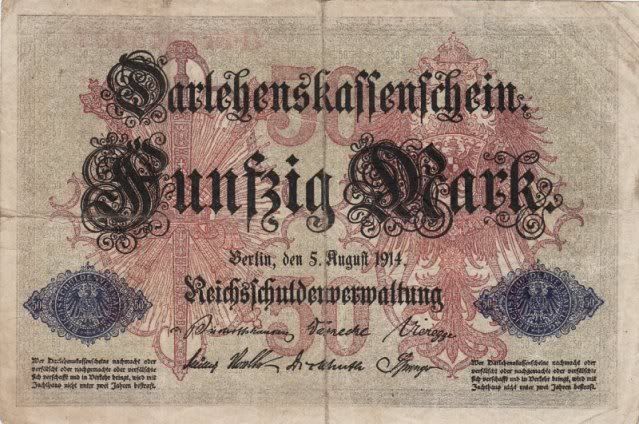

DARLEHENSKASSENSCHEINE
STATE LOAN CURRENCY NOTES
Year issue : 1914-1918
Size : 150mm x 100mm
Condition : FINE
---------------------------------------------------
- With the worsening coinage shortage at home, and the German government's actions as an example, the alternative was soon forth-coming! The decision to print locally acceptable, small change 'trading' currencies, with a redemption date, was quickly made at district levels, by German and Austrian-Hungarian Burgermeisters (mayors) and their councils, to suit the needs of their immediate community, town or city.
As the First World War ground on with its terrible toll mounting each day, the mundane things like keeping the 'home fires burning' and the making and selling of the essentials of life also ground on. With the official currency losing its buying power and the shortage of small change for the day to day needs of many communities creating serious economic hardship, a multitude of these local issue 'token' currencies referred to as Notgeld, Gutscheine, Kriegsgeld blossomed almost overnight. Most were made of paper and printed with various degrees of expertise depending on the size of the community and its resources.
Soon the practice became widespread throughout the Empire, with many businesses also printing their own notgeld, as the metal coinages disappeared rapidly from the banks and the pockets of the public.
The first reported issue, totalling only 100 Mark, was made as early as July 31st. 1914 by the Buergerliches Brauhaus GmbH, Bremen, in values of 1, 2, and 2.5 Mark, on heavy paper, with hand-written signatures but not serial numbered.
So many instances have now been recorded, and more are still coming to the notice of those that specialise in this area of collecting, that it is obvious that hundreds of thousands of different value notgeld were in the German Empire's economy during 1914 -18.
The notgeld from one area was often acceptable or interchangeable in near-by areas but, like any situation that requires a certain amount of trust, there were also those who would arrange for the sale and distribution into general circulation of huge amounts of unsecured notes, that were nearly past their 'use-by date', and then to dishonour the late redemptions to make a tidy profit. Because of the 'unofficial' nature of the local currency and the naivety of some of the issuers in those early days, the abusers of the system were quick to take advantage of any loopholes.
Some entrepreneurs even printed their own spurious paper notes, and over 110 instances are known where whole denomination ranges of bogus notgeld notes were manufactured in the Hamburg area for districts that didn't even exist. Because of the sheer scale of the frauds, these notes would often be accepted and circulate for months until the redemption dates became due and then - there would be no-where to redeem them!
--------------------------------------------------

No comments:
Post a Comment